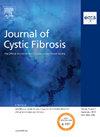将包裹ha标记CFTR mRNA的脂质纳米颗粒单次注入非人灵长类动物肺,可导致气道上皮中mRNA和蛋白的表达
IF 6
2区 医学
Q1 RESPIRATORY SYSTEM
引用次数: 0
摘要
气道上皮细胞是治疗囊性纤维化(CF)的关键治疗靶点,因为这些细胞中CF跨膜传导调节因子(CFTR)功能异常可驱动患者肺部疾病的进展。本研究的目的是评估包裹在脂质纳米颗粒(LNPs)中的CFTR mRNA在递送到非人类灵长类动物肺部时的细胞特异性生物分布和表达。方法对长尾猕猴(N=2 + 1)麻醉后,经气管内插管,用雾化气雾剂将ha标记的人CFTR mRNA包裹在ReCode Therapeutics LNP中。在24h采集肺组织,消化和facc分类,准备进行10X单细胞RNA测序和转录组学分析。利用定制的生物信息学和机器学习工作流程,评估具有特定转录组细胞谱系特征的分类细胞是否存在HA-CFTR mRNA。针对HA标签的免疫组织化学(IHC)检测被开发出来以确认mRNA货物的翻译保真度。结果对从EPCAM+肺细胞中分离的rna进行UMAP降维分析,并以细胞-基因矩阵的形式对10X Genomics scRNAseq测序数据进行分析,以可视化HA-CFTR和各种上皮气道标记基因的共定位。在人类肺图谱上训练的验证性机器学习模型用于对细胞类型进行分类并验证细胞的亲和性。数据显示HA-CFTR mRNA存在于多个亚型的气道上皮细胞中,包括SFTPB+离子细胞、SCGB1A1+分泌细胞、AGER+ AT 1型细胞和SFTPC+ AT 2型细胞。免疫组化证实了翻译的ha标记蛋白在分泌和基底气道细胞中的定位。通过结合生物信息学和空间工作流程,我们发现LNP-HA-CFTR mRNA的剂量导致新生和翻译货物递送到与CF相关的关键气道种群。本文章由计算机程序翻译,如有差异,请以英文原文为准。
WS05.03Single administration of a lipid nanoparticle encapsulating HA-tagged CFTR mRNA to non-human primate lung results in expression of mRNA and protein in airway epithelium
Objectives
Airway epithelial cells represent a key therapeutic target for the treatment of cystic fibrosis (CF), as abnormal CF transmembrane conductance regulator (CFTR) function in these cells drives the progression of lung disease in patients. The aim of the current study was to evaluate the cell-specific biodistribution and expression of a CFTR mRNA encapsulated in lipid nanoparticles (LNPs) upon delivery to the lungs of non-human primates.
Methods
Cynomolgus macaques (N=2 + 1 control) were anesthetized and delivered a HA-tagged human CFTR mRNA encapsulated in a ReCode Therapeutics LNP via intratracheal intubation in a nebulized aerosol. Lung tissues were harvested at 24h, digested and FAC-sorted in preparation for 10X single-cell RNA sequencing and transcriptomic analysis. Utilizing a custom bioinformatics and machine learning workflow, sorted cells with specific transcriptomic cell lineage signatures were evaluated for the presence of HA-CFTR mRNA. An immunohistochemistry (IHC) assay targeting the HA tag was developed to confirm the translational fidelity of the mRNA cargo.
Results
RNA isolated from EPCAM+ lung cells were analyzed using a UMAP dimensionality reduction on 10X Genomics scRNAseq sequencing data in the form of a cell-gene matrix to visualize the co-localization of HA-CFTR and various epithelial airway marker genes. A confirmatory machine learning model, trained on the Human Lung Atlas, was used to classify cell type and verify cell tropism. Data indicate presence of HA-CFTR mRNA in multiple sub-types of airway epithelial cells, including SFTPB+ ionocytes, SCGB1A1+ secretory cells, AGER+ AT Type 1 cells, and SFTPC+ AT Type 2 cells. IHC confirmed localization of the translated HA-tagged protein in secretory and basal airway cells.
Conclusions
Using a combinatory bioinformatic and spatial workflow, we show that dosing with LNP-HA-CFTR mRNA results in the delivery of nascent and translated cargo to key airway populations associated with CF.
求助全文
通过发布文献求助,成功后即可免费获取论文全文。
去求助
来源期刊

Journal of Cystic Fibrosis
医学-呼吸系统
CiteScore
10.10
自引率
13.50%
发文量
1361
审稿时长
50 days
期刊介绍:
The Journal of Cystic Fibrosis is the official journal of the European Cystic Fibrosis Society. The journal is devoted to promoting the research and treatment of cystic fibrosis. To this end the journal publishes original scientific articles, editorials, case reports, short communications and other information relevant to cystic fibrosis. The journal also publishes news and articles concerning the activities and policies of the ECFS as well as those of other societies related the ECFS.
 求助内容:
求助内容: 应助结果提醒方式:
应助结果提醒方式:


